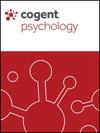The network structure of dysfunctional metacognitions, CAS strategies, and symptoms
IF 1.6
Q2 PSYCHOLOGY, MULTIDISCIPLINARY
引用次数: 1
Abstract
Abstract In the metacognitive model of psychological disorders, metacognitive strategies and corresponding underlying metacognitive beliefs intensify and maintain emotional distress symptoms. In the current study, our three objectives were to evaluate and replicate the network structure of dysfunctional metacognitions as assessed with the MCQ-30, to examine its stability when adding relevant covariates in the form of metacognitive strategies (worry and rumination) and symptoms (anxiety and depression), and to evaluate how different sets of dysfunctional metacognitions are more or less strongly linked differently to metacognitive strategies and symptoms. A cross-sectional university sample with a mean age of 26 years (N = 440; Males = 156, Females = 283) completed the Metacognitions Questionnaire–30, Penn State Worry Questionnaire, Ruminative Response Scale, and Hopkins Symptom Checklist. Data were analysed using psychological network analysis in R-studio statistical software. The network structure of dysfunctional metacognitions replicated well with item clusters that correspond to clinically meaningful substructures in the metacognitive model. Negative metacognitive beliefs and beliefs about uncontrollability might have more functional significance in the mutual connections between dysfunctional meta-domains as well as the connections with metacognitive strategies and symptoms. For worry and anxiety, negative beliefs about uncontrollability and corresponding danger of worry were more prominently connected in the network structure. For rumination, cognitive self-consciousness was more prominent, whereas for depression, need for control was more prominently connected. Support was found for mutual interdependence between different sets of dysfunctional metacognitive beliefs, that metacognitive beliefs are linked to but separate from metacognitive strategies, and that these may function together in affecting emotional distress symptoms元认知功能障碍的网络结构、CAS策略与症状
本文章由计算机程序翻译,如有差异,请以英文原文为准。
求助全文
约1分钟内获得全文
求助全文
来源期刊

Cogent Psychology
PSYCHOLOGY, MULTIDISCIPLINARY-
CiteScore
2.90
自引率
0.00%
发文量
75
审稿时长
12 weeks
期刊介绍:
One of the largest multidisciplinary open access journals serving the psychology community, Cogent Psychology provides a home for scientifically sound peer-reviewed research. Part of Taylor & Francis / Routledge, the journal provides authors with fast peer review and publication and, through open access publishing, endeavours to help authors share their knowledge with the world. Cogent Psychology particularly encourages interdisciplinary studies and also accepts replication studies and negative results. Cogent Psychology covers a broad range of topics and welcomes submissions in all areas of psychology, ranging from social psychology to neuroscience, and everything in between. Led by Editor-in-Chief Professor Peter Walla of Webster Private University, Austria, and supported by an expert editorial team from institutions across the globe, Cogent Psychology provides our authors with comprehensive and quality peer review. Rather than accepting manuscripts based on their level of importance or impact, editors assess manuscripts objectively, accepting valid, scientific research with sound rigorous methodology. Article-level metrics let the research speak for itself.
 求助内容:
求助内容: 应助结果提醒方式:
应助结果提醒方式:


